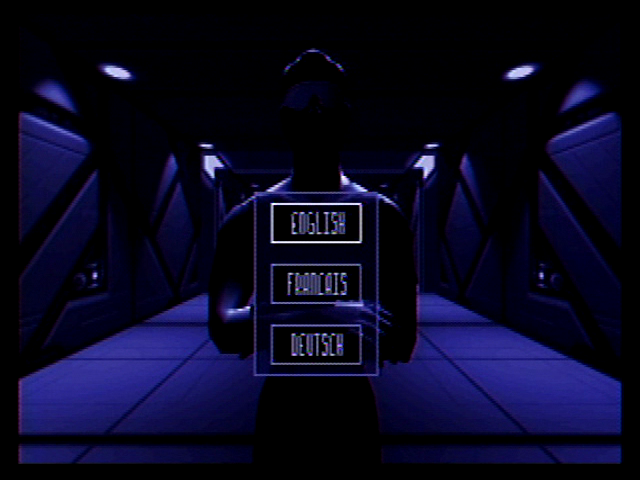Retro Replay Review
Gameplay
Cyberia delivers an eclectic mix of on-rails shooting, puzzle-solving, and vehicle combat that keeps the player on their toes from start to finish. The primary loop alternates between station-based puzzles—hacking terminals, manipulating power grids, and bypassing security protocols—and high-octane action sequences where you man turrets or pilot rotary-wing craft. This blend ensures that you never settle into a single rhythm for too long, as each new corridor or hangar bay often conceals a fresh gameplay twist.
(HEY YOU!! We hope you enjoy! We try not to run ads. So basically, this is a very expensive hobby running this site. Please consider joining us for updates, forums, and more. Network w/ us to make some cash or friends while retro gaming, and you can win some free retro games for posting. Okay, carry on 👍)
One of the most memorable gameplay segments involves taking control of anti-aircraft emplacements to shoot down inbound fighters in a style reminiscent of classic rail shooters. These sections are challenging but fair, demanding quick reflexes and precise timing. In contrast, the vehicle-based missions—where you pilot bespoke VTOL crafts through icy canyons and industrial caverns—feel more open, allowing a bit of lateral movement as you dodge incoming fire and line up shots on enemy transports.
Puzzle sequences break up the combat nicely, requiring you to decipher basic circuitry diagrams or rotate laser reflectors to unlock heavy security doors. While these challenges never reach the complexity of a full-blown adventure game, they provide enough brain-teasers to complement the adrenaline rush of the action parts. The scripted nature of many events helps guide the pacing, although a few players may find the on-rails limitations restrictive compared to fully explorable 3D environments.
Graphics
For its era, Cyberia’s graphics were a technical showcase, merging pre-rendered backgrounds with live 3D models in a seamless fashion. The Cyberia Complex itself is rendered with icy-blue steel corridors, ominous labs, and dimly lit service shafts that evoke a palpable sense of isolation. Character models—for both Zak and the various Cartel soldiers—appear slightly blocky by modern standards but were considered cutting-edge at release.
Cutscenes in Cyberia are fully pre-rendered, featuring cinematic camera angles and dramatic lighting effects that heighten the tension before each major mission. While these FMV sequences may feel dated today, they still stand out for their storytelling ambition, moving the plot forward with spliced-in audio dialogue and subtitle text. The transitions between gameplay and cutscene are surprisingly smooth, maintaining immersion even when shifting camera perspectives.
Enemy designs—from genetically engineered creatures to mechanized turrets—are distinct and well-textured, contributing to the variety of visual challenges. The flying vehicle sections showcase dynamic skyboxes, with snow-speckled mountainscapes or rusted industrial complexes whizzing past in convincing detail. Frame rates remain stable on most hardware of the era, though occasional slowdown can occur when many particle effects are on screen during heavy firefights.
Story
The narrative thrust of Cyberia pits two global superpowers—the western Free World Alliance and the eastern Cartel—against each other in a high-stakes struggle for a mysterious weapon. The prologue establishes this geopolitical conflict, with FWA leader Devlin recruiting the imprisoned cyber-hacker Zak to infiltrate the Cyberia Complex in Siberia. From the outset, you get the sense that this is no ordinary infiltration mission: at stake is a weapon that could tilt the balance of power worldwide.
As Zak ventures deeper into the complex, the story unfolds through a series of transmissions, captured video logs, and overheard conversations. You learn that Cartel agents have already overtaken large sections of the facility, forcing you into firefights against both trained soldiers and twisted biological experiments gone rogue. The script weaves in the scientist’s genetically engineered creations—hybrid beasts that add a horror element to the sci-fi thriller atmosphere.
What sets Cyberia’s story apart is its steady layering of intrigue and betrayal. While Devlin appears to be your ally, subtle hints suggest he may have ulterior motives, keeping players guessing about whom they can trust. The developers resist the urge to dump exposition all at once, preferring instead to drip-feed narrative beats via cutscenes and mission briefings, ensuring each revelation lands with maximum impact.
Overall Experience
Cyberia stands out as a seminal mid-’90s action-adventure title that ambitiously blends genres. Its strengths lie in its varied gameplay segments, atmospheric environments, and cinematic storytelling. The interplay between puzzles and action keeps the pacing brisk, while the overarching mystery of the Cyberia weapon provides a compelling narrative carrot to chase.
However, modern players should go in with tempered expectations. The on-rails nature of many sequences can feel restrictive compared to today’s fully open 3D worlds, and some puzzle mechanics may seem simplistic. Additionally, the dated graphics—and occasional FMV compression artifacts—remind you that the game was crafted during the early days of CD-ROM gaming.
Despite these minor drawbacks, Cyberia remains an engaging experience for fans of retro action titles and those intrigued by its Cold War–tinged sci-fi premise. Its unique mixture of shooting galleries, vehicle combat, and light puzzles, all wrapped in a tense narrative, delivers an overall package that is still worth exploring for anyone curious about gaming’s evolutionary path.
 Retro Replay Retro Replay gaming reviews, news, emulation, geek stuff and more!
Retro Replay Retro Replay gaming reviews, news, emulation, geek stuff and more!









Reviews
There are no reviews yet.